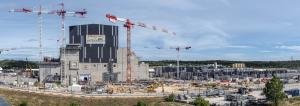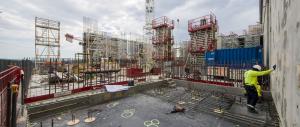Changing views
Twelve years after construction work began on the ITER platform, the installation has acquired its near-final appearance. More than 85 percent of civil works are now completed and—of the 40 buildings and technical areas that the installation comprises—only a few remain to be built.
Nondescript in appearance, they will accommodate an array of transformers, generators, rectifiers, inverters and other exotic electrical devices designed to feed 1 MeV ultra high voltage to the neutral injectors for durations of up to one hour—a unique electrical engineering feat.
The largest addition to the ITER platform however is yet to come. It will be in the form of a massive 200,000-cubic-metre, five-level structure sitting next to the Tokamak Complex—the Hot Cell Facility. Planning is in progress under the shared responsibility of the ITER Organization (requirements engineering, conceptual design, and the design, procurement, installation and commissioning of process equipment) and the European Domestic Agency (construction and commissioning of civil works and building services).




